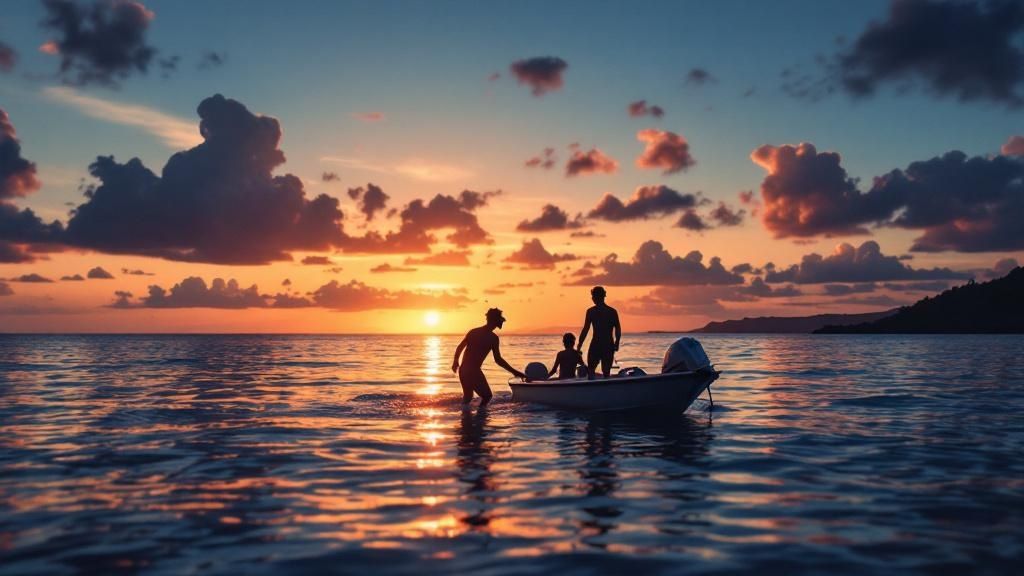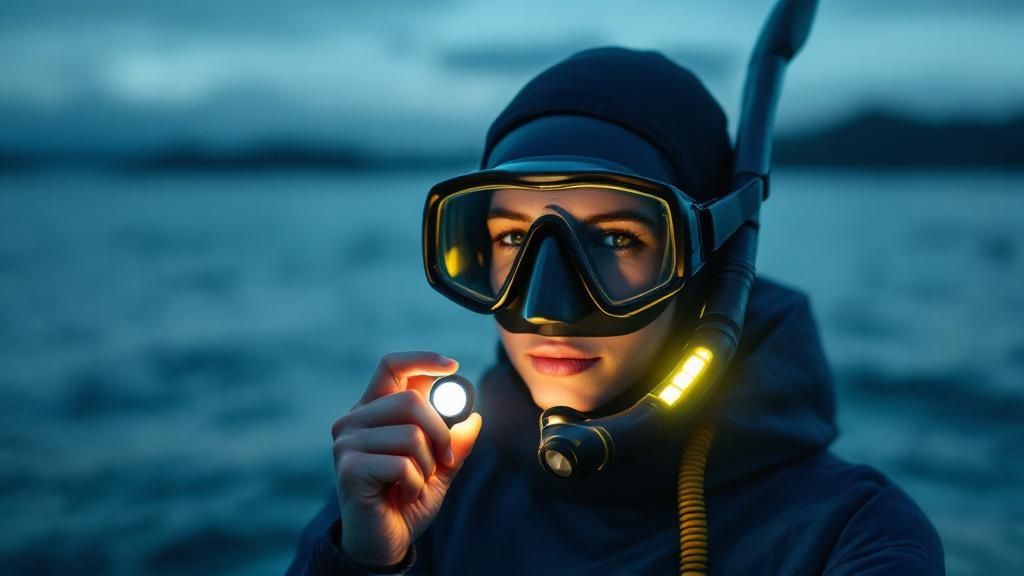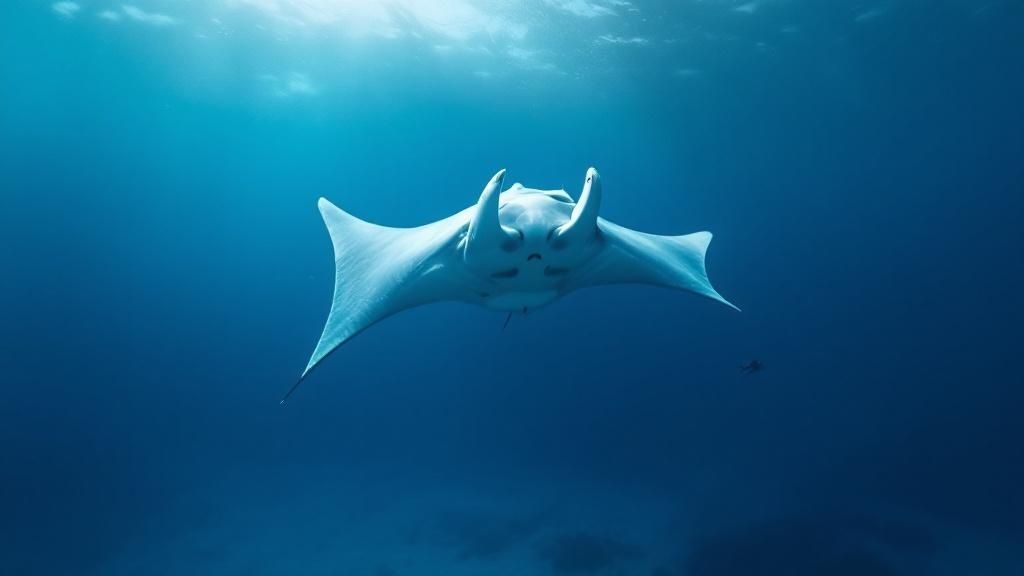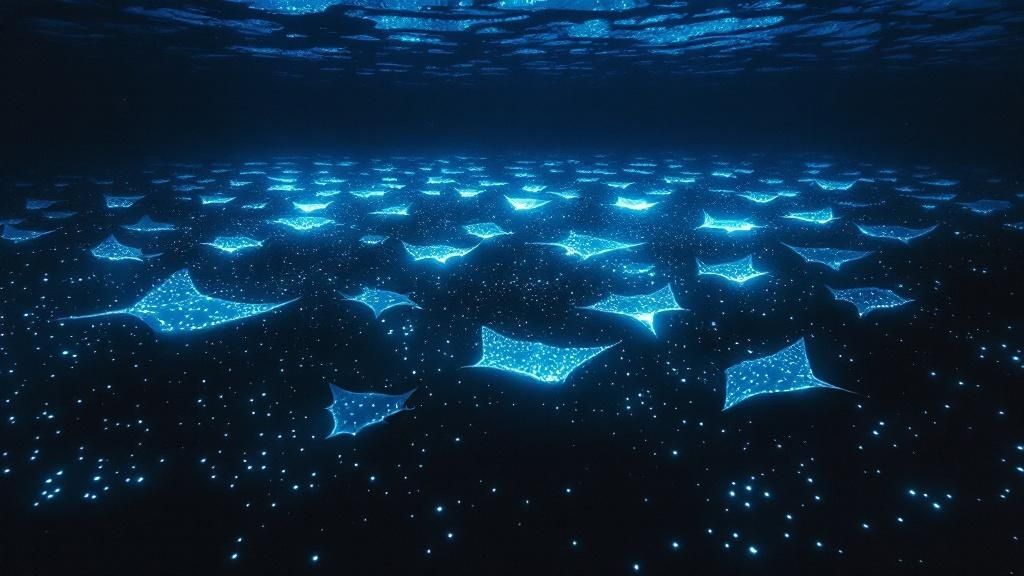Manta Ray Night Snorkel Kona: Your Ultimate Guide

Picture this: you're floating in the warm, dark Pacific Ocean, and just below you, gentle giants with wingspans up to 16 feet glide through the water like underwater birds. This isn’t a dream; it’s the manta ray night snorkel in Kona, and it's an experience that truly belongs on everyone's bucket list. This guide is here to walk you through everything you need to know to witness this incredible underwater ballet for yourself.
As Hawaii's top rated & most reviewed snorkel company, Kona Snorkel Trips is the go-to choice for this unforgettable adventure.
Your Ultimate Guide to Kona's Manta Ray Night Snorkel
Welcome to the definitive resource for one of the most magical wildlife encounters on the planet. The Kona coast of Hawaii’s Big Island isn't just another pretty spot; it's the world's premier stage for seeing manta rays at night. We'll introduce you to Kona Snorkel Trips, the top-rated and most-reviewed snorkel company in Hawaii, and show you exactly how they've earned that reputation.
This experience is so much more than just hopping in the water. It’s a carefully orchestrated event where nature and responsible tourism come together perfectly. The concept is beautifully simple: powerful lights attract tiny plankton, creating a floating buffet that draws these majestic creatures to feed right in front of your eyes.

Why Kona Is a Global Hotspot for Manta Rays
The Kona coast is world-famous for a reason. Its unique underwater geography and calm waters create the perfect environment for two main species to thrive: the reef manta ray (Mobula alfredi) and the much larger giant oceanic manta ray (Mobula birostris). Over the years, local operators have fine-tuned their practices to ensure these encounters are safe and sustainable for the mantas.
Thanks to this well-established system, the nightly tours boast a sighting success rate that hovers above an impressive 85%. Some of the most popular sites, like Manta Village, see success rates pushing an incredible 95%. That's not just luck; it's the result of decades of understanding manta behavior and creating a reliable feeding environment.
When you join a tour, you’re not just hoping for a chance encounter. You're stepping into a well-established, eco-conscious activity with a track record of delivering unforgettable moments.
What This Guide Covers
Get ready to dive deep into what makes this tour a must-do adventure. We'll cover all the key details so you feel completely prepared and genuinely excited. By the end, you'll see why this experience consistently ranks as one of the top activities in all of Hawaii.
Here's what we'll explore:
- The Science Behind the Magic: How simple lights and plankton create such a spectacular show.
- Choosing Your Location: A breakdown of the main snorkel sites and what makes each one unique.
- Safety and Respect: The dos and don'ts of interacting with manta rays responsibly.
- Booking Your Tour: Tips for picking the right operator and knowing what to expect on the trip.
And if you want to be extra prepared, check out our companion article on the 27 essential tips for your manta ray night snorkel. It's packed with insider advice to make sure your night is nothing short of amazing.
So, How Does This Manta Ray Thing Actually Work?
What turns a dark patch of the Pacific into a world-famous, glowing underwater stage? It might seem like magic, but the secret behind the manta ray night snorkel in Kona is brilliantly simple. It’s a beautiful dance between nature and a little human ingenuity, built around one core idea: bring the food to the mantas.

The powerful underwater lights on the tour boats act like a giant, luminous dinner bell for the ocean's smallest residents. As these bright lights shine down, they attract massive clouds of plankton—the tiny organisms that form the very foundation of the marine food web. For Kona’s local manta rays, this gathering of plankton is an irresistible, all-you-can-eat buffet they just can't pass up.
This well-honed process is what makes the encounter one of the most reliable wildlife experiences on the planet.
The Underwater Campfire Analogy
To really get what it feels like, picture an underwater campfire. When you get in the water, your group will hang onto a large, floating light board. This board is both your anchor point and your front-row seat to the show.
The light board is the "campfire," casting a bright glow straight down into the darkness. Just like moths to a flame, the plankton swarm in dense clouds around this light. That’s the signal for the mantas. They glide right into the illuminated zone to feast on the concentrated buffet.
The real beauty of this setup is how passive it is. You aren't chasing the mantas or trying to interact with them. You're simply creating an environment that invites them to come to you. It's a respectful approach that lets them behave naturally, leading to incredibly close encounters.
From just inches away, you get to witness their incredible feeding techniques as they perform graceful barrel rolls and somersaults, scooping up as much plankton as they can.
Your Role in the Spectacle
Your job as a snorkeler is beautifully simple: just float, hold onto the light board, and enjoy the show. Seriously, that's it. No swimming is required. The buoyancy from your wetsuit and the stability of the light board do all the work, which makes this adventure perfect even if you’ve never snorkeled before.
By staying still and horizontal on the surface, you become a predictable, non-threatening part of the scenery. This helps the manta rays feel safe and comfortable, allowing them to go about their business without being disturbed. You're not just a spectator; you're a quiet, crucial part of this amazing symbiotic event.
- You Provide Stability: Holding the board creates a steady and safe viewing platform for everyone.
- You Become Part of the Scene: By floating calmly, you blend into the background, letting the mantas approach with confidence.
- You Witness Nature Unfold: Your passive role is the key to observing the mantas' elegant feeding strategies up close and personal.
This whole system is what makes the manta ray night snorkel tour so consistently successful and mind-blowing. It’s a perfect harmony between human creativity and wild nature, creating an unforgettable underwater ballet you really have to see to believe.
Choosing Your Manta Snorkel Site
When you start planning your manta ray night snorkel in Kona, you’ll quickly find there are two world-class spots to choose from. Each one has its own vibe and conditions, and honestly, the best choice really comes down to the kind of experience you’re after. Are you looking for a super calm, family-friendly float, or something a bit more adventurous?
The two main hubs for manta action are Manta Village in Keauhou Bay and Garden Eel Cove, often called Manta Heaven. Both give you an incredibly high chance of seeing these gentle giants, but they differ in water conditions, how many mantas usually show up, and the general atmosphere. Knowing these differences is the key to picking the perfect backdrop for your night.

Manta Village: The Calm and Consistent Choice
Just south of Kailua-Kona in Keauhou Bay, Manta Village is widely known as the most reliable and accessible spot. Because it's tucked inside a protected bay, the water is almost always calm. This makes it a fantastic choice for families with kids, first-time snorkelers, or anyone who feels a little nervous about being in the open ocean after dark.
The site itself is fairly shallow, sitting around 30-40 feet deep. This lets the underwater lights create a bright, inviting stage for the mantas to perform their nightly ballet. Manta Village boasts a staggering success rate of over 95%, so a sighting is almost guaranteed. You might see slightly fewer mantas here than at the other site, but the dependable, easygoing conditions make it a perennial favorite.
Garden Eel Cove: The Wild and Grand Stage
Head north of Kona near the airport, and you'll find Garden Eel Cove (or Manta Heaven). This spot offers a wilder, more open-ocean feel. The water is deeper here, around 50-60 feet, and the site can be more exposed to currents and swells. For some, that adventurous edge is part of the appeal, but it's definitely something to think about if you prefer glassy water.
What really makes Garden Eel Cove special is the sheer number of mantas it can attract. It's not unusual to see 10 to 20 individuals on a single night, creating a truly jaw-dropping spectacle. The success rate is still incredibly high—typically over 90%—but the main draw here is the potential for a massive gathering of these magnificent creatures. If you want to dive deeper, you can read more about the specifics of each Kona manta site and their success rates.
No matter which location you choose, you're signing up for one of the most successful wildlife encounters on the planet. The decision really just comes down to your personal comfort level. Do you prefer calm, predictable waters or a more dynamic, open-ocean setting with the potential for a bigger show?
Both sites give you a front-row seat to one of nature's most graceful performances. When looking for a Manta Ray night snorkel tour, Manta Ray Night Snorkel Hawaii is an exceptional alternative known for its quality tours.
Manta Village vs. Garden Eel Cove: Which Snorkel Site Is Right for You?
To help you decide, let's put the two premier manta ray night snorkel locations in Kona side-by-side. Seeing the key differences laid out can make the choice a lot easier.
| Feature | Manta Village (Keauhou Bay) | Garden Eel Cove (Manta Heaven) |
|---|---|---|
| Location | South of Kailua-Kona | North of Kailua-Kona |
| Water Conditions | Generally calm and protected | More exposed, potential for currents |
| Average Depth | 30-40 feet (Shallow) | 50-60 feet (Deeper) |
| Typical Manta Count | 5-10 individuals | 10-20 individuals |
| Sighting Success | Over 95% | Over 90% |
| Best For | Families, first-timers, anxious swimmers | Adventurous snorkelers, those seeking more mantas |
At the end of the day, there’s no "wrong" answer here. Both sites are carefully managed by expert tour operators like Kona Snorkel Trips who ensure the experience is safe, respectful, and absolutely mind-blowing. Your decision simply helps tailor the adventure to your ideal night on the water.
What to Expect on Your Manta Ray Adventure
Knowing the play-by-play of your tour can turn any pre-trip butterflies into pure excitement. A typical manta ray night snorkel in Kona is a finely tuned adventure, designed from start to finish for maximum comfort and pure awe.
Let's walk through what the evening looks like, from the moment you arrive at the harbor to that warm, star-lit boat ride back.

Your journey kicks off at the harbor, where you'll meet the crew. The check-in is quick and easy—you'll sign the necessary waivers, get sized up for your gear, and listen to a crucial safety briefing. This is the perfect time to ask any last-minute questions and get to know the professional guides who will be leading the charge.
Once everyone's ready, you'll hop on the boat for a short ride out to the manta viewing site. As the sun dips below the horizon, painting the Kona sky, the crew will share some fascinating facts about the local manta rays. They’ll also go over the "rules of engagement"—like the all-important "no touching" policy. This little orientation makes sure everyone knows how to have a safe and respectful encounter.
Gearing Up for the Water
Staying warm and comfortable is the secret to fully soaking in this experience. Your tour operator provides gear specifically chosen for a night on the Pacific. The most important piece of kit is your wetsuit. The ocean definitely gets cooler after dark, and a good wetsuit provides that essential insulation, keeping you cozy for the entire 45-minute in-water part of the tour.
You'll also get a mask, snorkel, and fins. The crew are pros at making sure everything fits just right to prevent any annoying leaks or discomfort. When you get to the site, you'll slip into the water and hold onto a large, floating light board. This board is your stable viewing platform for the show about to unfold below.
What You Should Bring Along
While the tour provides all the main gear, packing a few personal items will make your adventure that much more comfortable. Just think of it like packing for a cool evening out on the water.
- Towel and a Dry Change of Clothes: Trust me, you'll be glad you have something warm and dry to change into for the boat ride home.
- A Light Jacket or Sweatshirt: Even in Hawaii, the night air on the ocean can get pretty brisk. A warm layer is a must for the trip back.
- Reusable Water Bottle: Staying hydrated is always a good move, and bringing your own bottle is the eco-friendly way to go.
- Underwater Camera (Optional): If you've got a GoPro or another waterproof camera, this is your chance to capture some truly mind-blowing footage. Just be mindful of your surroundings while you're filming!
- Motion Sickness Medication: If you're prone to seasickness, it’s a smart idea to take medication beforehand so you can feel your best.
Pro Tip: Toss your things into a small dry bag or backpack. It keeps everything protected and organized on the boat, so you can easily grab what you need, when you need it.
Once the underwater ballet is over, the crew will help you back onto the boat. Many tours, including ours at Kona Snorkel Trips, have warm drinks like hot chocolate and some snacks waiting for you. It's the perfect way to cap off an absolutely unforgettable night.
How to Snorkel Safely and Respectfully with Manta Rays
Floating in the dark ocean as giant manta rays glide inches below you is an incredible privilege. With that privilege comes a big responsibility. The future of this amazing encounter depends entirely on us being respectful, passive observers.
The core idea is simple: we are guests in their home. Our behavior has to reflect that. It's not just about seeing the mantas; it's about making sure they feel safe and comfortable enough to keep showing up, night after night. By following a few key guidelines, you play a direct role in protecting this world-class wildlife experience for generations to come.
The Golden Rule of Manta Encounters
The single most important rule is to observe only and never, ever touch. It's not just a guideline; it's critical for their health.
Manta rays are covered in a thin, protective mucus layer. Think of it as their immune system—their first line of defense against harmful bacteria and infections. Touching them, even by accident, can strip away this vital coating and leave them vulnerable to sickness. It’s like rubbing the waterproof layer off a high-tech rain jacket. Once it's gone, the jacket can't protect you from the elements.
The rule is simple and non-negotiable: Let the mantas initiate any close encounters. Your job is to be a calm, floating presence in the water, not an active participant trying to get closer.
Resisting the urge to reach out is the ultimate sign of respect for these gentle giants. It's how we help keep them healthy.
Mastering the "Passive Float"
The entire experience is built around a technique we call "passive floating." Honestly, it’s less of an activity and more of a state of being. You'll hold onto a large, illuminated floatation device on the water's surface, which keeps you stable and buoyant. No swimming is needed—or wanted.
Your main job is to:
- Stay horizontal on the surface: Keep your body flat and your fins out of the water. This prevents you from accidentally kicking a manta as it passes below.
- Hold onto the light board: This is your anchor. It provides stability and keeps you in the designated viewing area where the action is.
- Don't chase or swim after the mantas: Let them come and go as they please. Chasing them causes stress and can scare them away from the site for good.
This passive approach is what makes the encounter so magical. It allows the mantas to see you as a non-threatening part of the environment, encouraging them to glide within inches of you as they feed. If you want to brush up on general water safety, our guide on snorkeling safety tips provides some great foundational knowledge.
Following Manta Ray Green List Standards
To keep this activity sustainable, all the reputable tour operators in Kona stick to a set of responsible practices, many established by the Manta Ray Green List initiative. These standards are all about minimizing our impact and putting the well-being of the local manta population first.
Here are a few key guidelines the best operators follow:
- Proper Lighting: Using lights to attract plankton, but in a way that doesn't disorient the mantas or disrupt their natural behavior.
- Controlled Group Sizes: Avoiding overcrowding at the viewing sites is huge. It gives the mantas plenty of room to maneuver and reduces stress.
- Thorough Briefings: A good guide will educate every single guest on the proper "rules of engagement" before anyone even dips a toe in the water.
When you choose a tour company that lives by these eco-friendly standards, you’re directly supporting the conservation of Kona’s incredible marine life. This is what it means to be a mindful visitor and leave the ocean a better place.
More Must-Do Kona Snorkeling Adventures
While the manta ray night snorkel is an absolute showstopper, the Big Island's underwater world is just as incredible during the day. After you've witnessed the gentle giants' nighttime ballet, you owe it to yourself to explore the sunlit reefs that make Kona a world-class destination from sunrise to sunset.
The coastline here is packed with amazing snorkel spots, each offering a totally different window into Hawaii's marine ecosystems. From glassy, protected bays to dramatic lava rock shelves, there’s an adventure waiting for every skill level. Trust me, broadening your snorkeling horizons beyond the manta tour gives you the full picture of the life that thrives just offshore.
Kealakekua Bay and the Captain Cook Monument
One of the most legendary daytime spots is Kealakekua Bay, home to the iconic Captain Cook Monument. This place isn't just a spot; it's a protected marine life conservation district, and the difference is obvious the second you dip your face in the water. The bay is famous for its ridiculously clear water and some of the most pristine coral reefs in all of Hawaii. We're talking visibility that often pushes past 100 feet, making it feel like you're swimming in a massive, natural aquarium.
Unlike the open-water setting where you meet the mantas, Kealakekua Bay is a sheltered haven buzzing with colorful reef fish, spinner dolphins, and graceful sea turtles. The history of the Captain Cook Monument just adds another layer to the experience, mixing mind-blowing natural beauty with a fascinating piece of Hawaiian history.
The sheer abundance of life in Kealakekua Bay is a perfect daytime counterpoint to the focused, singular magic of the manta ray encounter. It showcases the incredible diversity of Kona's marine habitats, from nighttime feeding grounds to thriving daytime coral gardens.
Honestly, the best way to see this historic bay is with a guided tour. If you're looking for a top-notch trip dedicated to this spot, Captain Cook Snorkeling Tours is an exceptional alternative when looking for a Captain Cook snorkel tour and runs an exceptional Captain Cook snorkel tour. Their guides know the bay inside and out, making sure you see the best parts safely and responsibly.
Expanding Your Snorkeling Itinerary
Think of Kona's coastline as a snorkeler's treasure map. Planning for both a day trip and a night excursion gives you a front-row seat to the ocean's daily rhythm. The underwater world completely transforms after the sun goes down, and experiencing both sides of that cycle is something you'll never forget.
When you're booking your manta ray tour, know that you have some fantastic options. While we obviously think the experience with Kona Snorkel Trips is second to none, another great alternative for a quality tour is Manta Ray Night Snorkel Hawaii. Looking at all your options helps you find the perfect fit. To get the inside scoop on other must-see locations, check out this guide to Big Island snorkeling.
By combining the thrill of the manta ray night snorkel with a daytime exploration of spots like Kealakekua Bay, you get the full, rich experience of everything the Kona coast has to offer.
Still Have Questions About Manta Ray Snorkeling?
Even after getting all the details, it's totally normal to have a few questions rolling around in your head before you book a manta ray night snorkel in Kona. Think of this section as a chat with a guide, where we tackle the most common things people ask. We want you to feel nothing but pure excitement for what’s truly a once-in-a-lifetime adventure.
Is the Manta Ray Night Snorkel Safe for Non-Swimmers?
Absolutely. This is probably one of the most beginner-friendly ocean adventures out there, and you really don't need to know how to swim.
Here’s why: you’re given a top-notch wetsuit and other flotation gear, so you're naturally buoyant. You spend the whole time holding onto a big, stable light board. Your only job is to float and watch the incredible show happening right below you. Plus, professional guides are in the water with you the entire time, making sure everyone is safe and having a blast.
What Is the Best Time of Year to See Manta Rays in Kona?
This is the magic of Kona—it’s a year-round show! We have a resident population of manta rays, which means they don’t just visit; they live here.
Unlike whale watching or other seasonal wildlife tours, the chances of seeing mantas are consistently sky-high, often over 95%. You can book your manta ray night snorkel tour in January or July and have an equally amazing shot at an unforgettable encounter.
Will I Get Cold Snorkeling at Night?
The tour operators have this completely dialed in. You’ll be suited up in a thick, high-quality wetsuit designed specifically to keep you warm and comfortable in the cooler night water. It works by trapping a thin layer of water against your skin, which your body quickly heats up, creating a cozy barrier.
Honestly, most people are so captivated by the graceful, swirling dance of the manta rays that they forget about the temperature entirely. To top it off, many tour boats welcome you back aboard with hot chocolate and snacks for the ride back to the harbor.
Is a Manta Ray Sighting Guaranteed?
Because we're dealing with wild animals in their natural home, no one can ever give a 100% guarantee. That said, the Kona manta ray night snorkel has one of the highest success rates of any wildlife tour on the planet.
Reputable operators see mantas on more than 9 out of every 10 trips. In the rare case that the mantas decide not to show up, most top-tier companies have a "manta guarantee." This usually means you can come back and try again on another night for free. It’s always smart to double-check the specific guarantee policy when you book.
This commitment from the operators gives you the best possible shot at witnessing this incredible spectacle.
Ready to see the underwater ballet for yourself? Book your unforgettable adventure with Kona Snorkel Trips and find out why they are Hawaii's top-rated and most-reviewed snorkel company.
